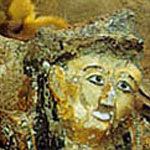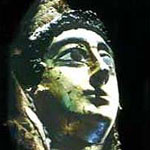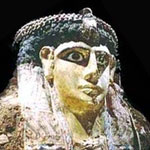|
 |
In
March 1999, I took a team of archaeologists, architects,
restorers, conservators and engineers and started
the largest expedition ever in Egypt.
We
established a large camp in the area which is
located about 6 km from the town of El Bawiti,
the capital of Bahriya Oasis. We conducted a survey
and found that the cemetery was about 6 km square.
We
started the excavation in four tombs only and
found 105 mummies inside them. The mummies are
in good condition showing the richness of the
people in that time.
|
They
are of four kinds:
· Mummies which are guilded, covered with a very
thin layer of gold;
· Mummies covered with cartonage depicting scenes,
such as gods and goddesses. For example, Anubis of the
embalment, Osiris, Isis, and the four children of Horus
as well as the god Toth. All these gods are connected
with the judgement;
· The third type are mummies inside anthropoid
coffins (these are coffins made of pottery with human
faces);
· The last style are mummies wrapped in linen.
 |
Lots
of artifacts were found near the mummies, such
as statues of mourning ladies made of pottery.
Other artifacts, such as different types of pottery
in the shapes of the God Bes, the dwarf god of
pleasure and fun.
Other
artifacts including bracelets, earrings and coins
were found. The study of these coins reveal that
this find dates from the Greek to the Roman Period.
The
Tombs consist of an entrance, delivery room and
two burial chambers. One of the mummies is a guilded
lady with her head turned toward the face of her
husband with love and affection. Others are buried
as a family group, with their children. The mummies
of the children were covered with gold.
|
Another
woman has a crown with four decorative rows of red-coloured
curls. The third and fourth rows are missing significant
pieces. Beneath the crown the hairstyle is similar to
that of Terracotta statues. Behind the ears appears
the goddess Isis on one side and Nephthys on the other
- these protect the deceased with their wings.
The
decorative scenes show an abbreviated form of the judgement
of the dead. In these scenes we see the god Osiris on
his throne while Anubis weighs the heart of the dead
against the feather of Maat. Meanwhile, Toth records
the result of the weighing process and reports it to
Osiris.
 |
Anubis,
who is portrayed on the mummies, played an important
role in several ways. First is his well attested
role in the judgement scenes - it is he who operates
the scale on which the heart is weighed against
the feather. Second is his performance of the embalming
- a basic condition for rebirth. Anubis protects
the body of the deceased and assists in its revival.
Therefore, we find Anubis in the representations
on coffins and mummy masks performing mummification
rites.
The
Uraeus appears on the head of some of the mummies
belonging to non-royal persons. This probably
indicates the desire of the deceased to have a
transfiguration similar to that of a king.
|
In
the Roman Period, different elements appear - such as
crowns and the use of a king's or god's beard of Uraeus,
taken from the royal cult and used by the public.
We
expect to find at least 10,000 mummies in this cemetery.
We preserved mostly all the mummies in situ, but we
did move only a few to a room in the Bahariya inspectorate
to show them to the public.
|